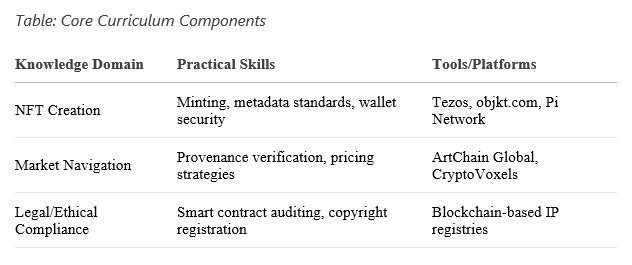Blockchain in Art Education: How Institutions Can Prepare Students for the Digital Asset Revolution
The fusion of art, blockchain, and digital assets represents more than a technological trend—it’s a fundamental restructuring of creative economies.
The Converging Realities: Why Blockchain Matters for Art’s Future
The fusion of art, blockchain, and digital assets represents more than a technological trend—it’s a fundamental restructuring of creative economies. Blockchain’s decentralized ledgers enable verifiable ownership of digital artworks, while NFTs create new revenue streams and collection models.
For art institutions, this convergence demands urgent curricular evolution. As Australian artist John Young observed, "Blockchain will transform our worldview of art just as photography did in the 19th century—redefining originality, reproducibility, and value" 6. Students unprepared for this paradigm will face significant disadvantages in galleries, auctions, and digital art markets.
This article provides you with:
Strategies for integrating blockchain literacy into art curricula
Case studies of successful academic-industry partnerships in Web3 art
Frameworks for teaching digital ownership and NFT creation
Solutions for copyright protection using blockchain technology
Roadmap for addressing ethical and technical challenges in digital asset education
Sponsored by Art8 “Webinars for Creatives”
Academic Pioneers: Current Integration Models
Forward-thinking institutions are already building bridges between art pedagogy and blockchain:
Blind Gallery Academy (Tezos-powered): This platform offers asynchronous courses for artists, curators, and collectors, culminating in NFT-based certificates. Its industry-aligned curriculum covers blockchain art markets, NFT minting, and decentralized curation 1.
Central Academy of Fine Arts (China): Through its "Encrypted Era" program with BCA Academy, students explore Web3 content creation, NFT economics, and blockchain applications across fashion, music, and gaming industries. The program includes industry-recognized credentials and gallery exhibitions 4.
Nanjing Art Institute: Their blockchain-powered digital exhibition platform authenticates student works via on-chain certificates, solving copyright challenges while teaching practical digital provenance skills 3.
Table: Blockchain Education Initiatives Comparison
To prepare students for Web3 art ecosystems, institutions must integrate these core competencies:
1. Technical Foundations
NFT Creation Workflows: Hands-on training in minting platforms (e.g., fx(hash), wallet management, and gas optimization. Hong Kong’s Yan Tak Catholic Primary School demonstrated this accessibility by having students create NFTs themed "Our School in My Eyes" using photography and AI tools 9.
Smart Contract Literacy: Understanding royalties, resale rights, and automated gallery agreements through platforms like Tezos and Ethereum.
2. Art Market Transformation
Decentralized Valuation Frameworks: Analyzing how platforms like ArtChain Global combat art fraud through immutable provenance tracking 6.
Tokenomics for Creatives: Revenue models including fractional ownership, DAO-governed collections, and community tokens.
3. Philosophical & Legal Dimensions
Digital ownership ethics and environmental impact debates
Copyright frameworks for on-chain artworks and metaverse exhibitions
Table: Core Curriculum Components
Partnership Blueprint: Academia Meets Industry
Successful blockchain-art education requires cross-sector collaboration:
Corporate Pedagogy: OKX’s "NFT For School" initiative partnered with NGOs and schools to deliver digital literacy workshops, demonstrating how exchanges can supply technical infrastructure 9.
Gallery-Academy Pipelines: Blind Gallery’s model invites professionals to develop courses, ensuring curricula reflect market needs 1.
Research Synergies: Swinburne University’s blockchain lab integrates artists, computer scientists, and legal experts to explore creative applications beyond finance 6.
Student Readiness: Beyond Technical Skills
Preparing art professionals requires cultivating adaptive mindsets:
Entrepreneurial Fluency: Training students to launch NFT projects like CAFA-BCA participants, who deploy IP across fashion and gaming verticals 4.
Critical Engagement: Balancing adoption with critique of market speculation, environmental costs, and accessibility barriers.
Metaverse Curation: Virtual exhibition design using platforms like Decentraland and Spatial.
Overcoming Institutional Challenges
Key implementation hurdles and solutions:
Accessibility: Adopt tiered learning (e.g., Polkadot’s PBA-X online school) that scaffolds novices from fundamentals to advanced DApp development 8.
Faculty Development: Incentivize instructor upskilling through industry residencies and credentials like BCA’s educator programs 4.
Infrastructure: Leverage cost-efficient chains (Tezos, Pi Network) for student projects to minimize gas fees and environmental impact 15.
The Road Ahead
Art institutions stand at a transformative crossroads. By embedding blockchain literacy into curricula, forging industry alliances, and empowering students as critical creators—not just consumers—of Web3 systems, educators can democratize the digital art renaissance. As Kaloh of Blind Gallery Academy notes, "We’re building a community where blockchain art knowledge becomes accessible, engaging, and evolutionary"
The mandate is clear: equip students not merely to navigate the digital asset landscape, but to redefine its contours.
→ Actionable Next Steps for Institutions:
Audit existing programs for blockchain integration opportunities
Partner with galleries (e.g., Blind Gallery) and platforms (e.g., Tezos) for resource sharing
Launch student NFT exhibitions with copyright safeguards like Nanjing’s blockchain system
Develop faculty "train-the-trainer" initiatives with industry certifications
The canvas of art’s future is being coded today. Academic leaders who wield blockchain as both pedagogical tool and creative medium will shape the next epoch of cultural production.
Art Institute Spotlight:
School of the Art Institute of Chicago (SAIC)
A Romp with Gladys Nilsson
The mural, Caked: a plein air romp with bakery goods, was created with Gladys’s 85th birthday in mind and is as joyful and animated as its creator. It’s a playful tribute to her signature style, filled with romping characters, swirling colors, and cheeky nods to her favorite dessert: carrot cake.
A graduate of the School of the Art Institute of Chicago (SAIC) and a beloved faculty member for over 30 years, Gladys Nilsson has been a cornerstone of the city’s art world for decades. In the 1960s, she was one of six members of the Hairy Who, a group of recent SAIC grads who shook up the local art scene with their wildly imaginative, graphic, and often humorous work. Their legacy helped define Chicago’s underground art movement and left a lasting mark.
Discover the World’s Top Art Institutes at https://artinstitutes.org








